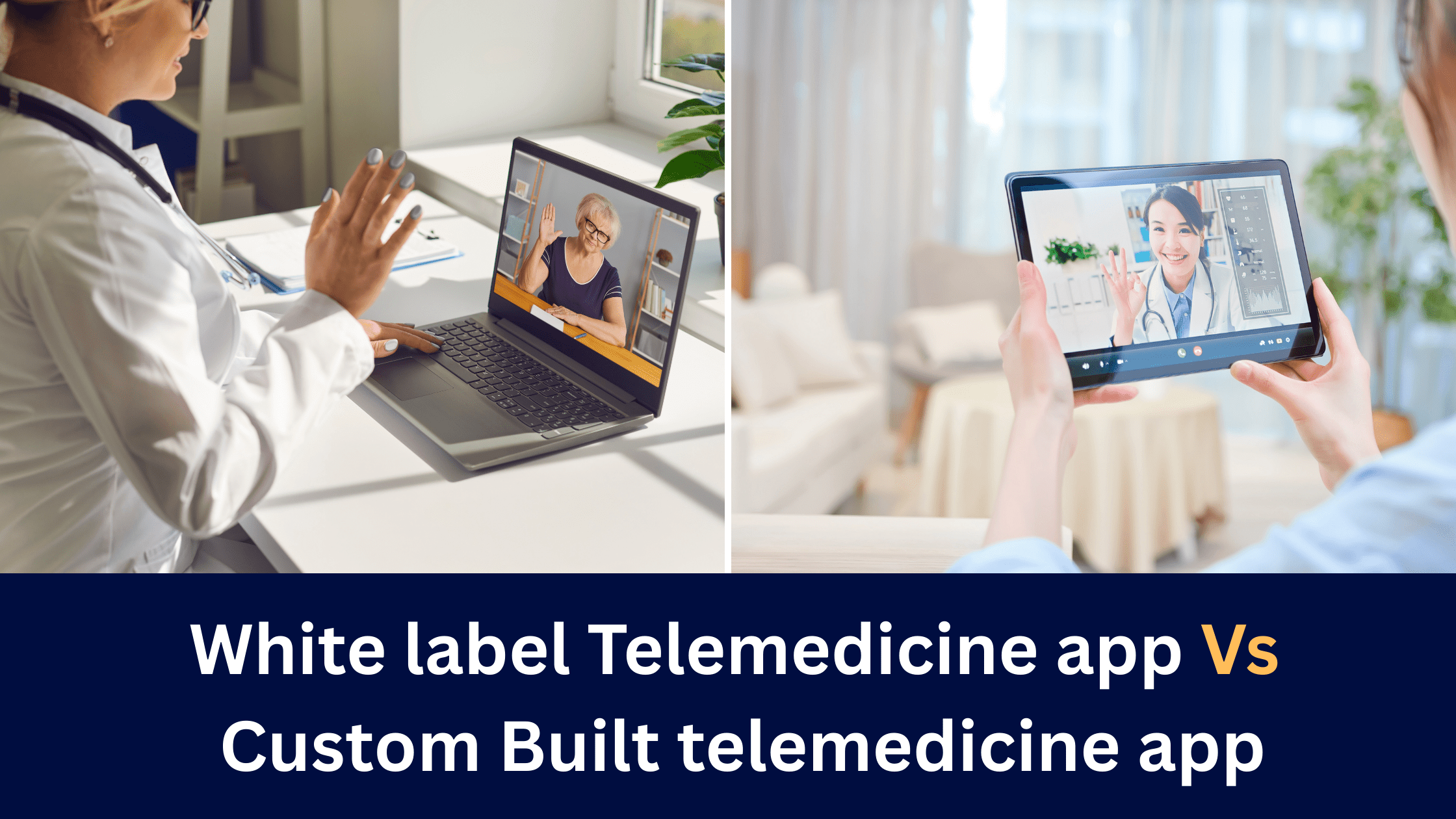
Summary: Deciding between a white label telemedicine app and custom telemedicine software isn’t easy. A telehealth white label solution gets you to market faster and at a lower cost, while custom development offers full control but requires a bigger budget and more time. This post explores the pros, cons, and real-world examples of both approaches — plus why choosing a flexible white label telehealth platform might be the smartest middle ground.
Table of Contents
Introduction
When clinics or healthcare startups decide to go digital, one of the first big choices is whether to launch with a white label telemedicine app or invest in custom telemedicine software. Both sound good on paper, but the right pick depends on your goals, budget, and how fast you want to get moving.
Telemedicine isn’t some “nice to have” anymore — it’s the main door through which many patients first connect with doctors. Just think back to the pandemic when small clinics scrambled to stay connected with their patients. Some went the quick route with a telehealth white label solution so they could be up and running in weeks. Others spent months (sometimes over a year) trying to build a completely custom telemedicine software system — which meant patients had already switched over to competitors by the time the product was ready.
Take the example of a mid-sized family clinic in Texas. They didn’t have the money or time to build an app from scratch, so they launched a white label telehealth platform branded with their own logo and patient portal. Within a month, they were scheduling video visits, handling prescriptions, and keeping up with patient demand. Later, after they saw what worked (and what didn’t), they started budgeting for a more custom telemedicine app with extra features like home health monitoring and integration with their in-house EHR system.
So here’s the deal. A white label telehealth platform is basically a pre-built app that you can rebrand as your own. The heavy lifting — video calls, scheduling, secure messaging — it’s already done. You just throw on your clinic’s name, logo, colors, maybe swap out a feature or two, and boom, you’ve got a white label telemedicine app ready to go.
It’s kind of like moving into a furnished apartment. The basics are there — the couch, the Wi-Fi, even a coffee table. You don’t get to knock down walls or build a fancy walk-in closet, but you can hang your own photos and call it home. Same thing with a telehealth white label solution: it’s not totally “yours,” but it’s close enough to get rolling fast.
Real-world example: a small dermatology clinic in California wanted to test out online consults. No way they could afford months of dev work or a big IT budget. So they grabbed a white label telehealth app, slapped their brand on it, and were seeing patients online in about three weeks. Patients didn’t even realize it wasn’t custom-built. To them, it was “the clinic’s app.” And honestly, that’s all that really mattered.
Upsides:
- You can launch crazy fast — we’re talking weeks, not a year.
- It’s cheaper upfront, which is a lifesaver for small clinics.
- Security and compliance usually come baked in (HIPAA, etc).
Downsides:
- You’re stuck with whatever features are in the box.
- Competitors might have apps that look kinda similar under the hood.
learn more about – The Advantages of White Label Video Consultation Solutions
What About Custom Telemedicine Software?
When people talk about going custom, they mean custom telemedicine software — basically building your own app from scratch. Nothing’s pre-made, you’re in charge of every little detail. The buttons, the workflows, the integrations — all of it. It’s kind of like saying, “nah, I don’t want to rent, I’ll just build my own house.” You pick the layout, the tiles, even what kind of door handles you want. Super flexible, but yeah, also a lot more work.
Sounds amazing, right? And it can be. Big hospital systems and healthcare networks often go this route because they need very specific things — like connecting to their in-house EHR, or handling thousands of doctors and patients at the same time.
But here’s the catch: it takes time and money. Lots of it. Development can run into the hundreds of thousands (sometimes more), and you’re looking at months before you even get a beta version in front of patients. Plus, you’ll need a tech team for ongoing support — bugs don’t fix themselves.
Real-world example: A behavioral health startup in New York wanted their platform to include custom care plans, integration with wearables, and advanced analytics. No off-the-shelf white label telemedicine app could do all that, so they went custom. It took them almost a year to launch, and the budget ballooned way beyond what they expected. But now they’ve got something truly unique, and investors like the fact that no competitor can just copy-paste their system.
Upsides of Custom Telemedicine Software:
- Total control — you decide what features exist.
- It scales exactly how you need it to.
- Gives you a competitive edge (nobody else has your app).
Downsides:
- It’s expensive. Like, really expensive.
- Takes months (sometimes a year) to launch.
- You’ll always need developers around for updates and fixes.
Learn more abot – Step-by-Step Guide for Successful Telemedicine App Development
The Cost Question: White Label vs. Custom
Money talks, right? And honestly, the gap between a white label telehealth platform and custom telemedicine software is pretty huge — both in dollars and in how long it takes to actually launch.
How much does White Label Telehealth Cost?
If you’re going white label, you’re looking at something that’s way more budget-friendly. Basic packages can start around $2,200 and go up to about $28,000 if you want more bells and whistles or some extra customization. Most vendors will charge a one-time setup fee and then a subscription — something like $25/month per provider isn’t unusual. The nice thing? You can usually go live in 2–4 weeks. That’s a lifesaver if you need to hit the market fast without building a big IT department from scratch.
How much does Custom Telemedicine Software Cost?
Now, if you go the custom route, be ready for a serious spend. You’re talking $40,000 at the very low end, and anywhere from $300,000 to $450,000 if you’re building a big, feature-heavy system. Costs pile up because of complexity — more integrations, stricter security requirements, custom workflows — they all add hours and invoices. Timelines stretch out too: maybe 2–3 months for a super simple build, but usually closer to 9 months (or more) for something enterprise-grade. And remember, once it’s live, you’ll still need your own tech team to keep it updated, secure, and compliant.
Learn more about – Customizing Your White-Label Telehealth Platform
Strategic Considerations
Here’s the straight talk: going with a white label telehealth app can save you a chunk of money — sometimes as much as 65% compared to building from scratch. That’s why small clinics and lean startups usually jump on it. It’s fast, it’s cheap, and it gets you in front of patients without draining your bank account.
Custom builds, though, aren’t pointless — they just make more sense when you’re bigger or when you’ve got needs that are… let’s say “not standard.” Like maybe you need to tie into three different EHRs, or you’ve got a weird workflow that no off-the-shelf app is ever gonna cover. In those cases, spending the extra money is kinda the only way to get what you want.
And don’t forget the “hidden” part: maintenance. With white label, the vendor’s team usually handles updates, security patches, HIPAA compliance headaches — all that. With custom, that responsibility sits on your shoulders (or your dev team’s). So yeah, the costs don’t stop at launch.
It’s Not Always Either/Or
Here’s the thing nobody really tells you: you don’t always have to pick just one path and stick with it forever. A lot of clinics and startups start off with a white label telehealth platform just to get something out the door quickly. Patients don’t care if it’s custom-built or not — they just want an easy way to book an appointment and talk to their doctor without driving across town.
Once the clinic is rolling, and money’s actually coming in, then they start thinking about a custom telemedicine app. By that point, they know what features their patients actually use, what’s missing, and what workflows are slowing them down. Building custom at that stage makes way more sense because you’re not guessing — you’re upgrading.
So sometimes the smartest play is not choosing sides, but using both — start lean with white label telehealth apps, then grow into custom telemedicine software when you’re ready.
Choosing a Flexible White Label Telehealth Solution
But here’s something else to consider, while some white label solutions are pretty much “what you see is what you get,” others (like QuickBlox’s Q-Consultation) give you more wiggle room. They allow for greater customization so that you can create the solution you need. That means you get the speed and cost benefits of white label, plus the option to tweak things when your clinic needs something extra.
For example, maybe you start with a basic white label telemedicine app but then realize you want to add payments directly in the app, or you want to shuffle the workflow so patients fill out an intake form before the call, or maybe you only want chat — no video. With a flexible provider, that’s all possible. Sure, there’s usually an extra cost for custom tweaks, but it’s still miles cheaper (and faster) than building from scratch.
So when you’re shopping for a telehealth white label solution, don’t just ask, “what does it come with?” Ask, “what can I change later if I need to?” The right vendor won’t lock you into a rigid box — they’ll help you grow into something that feels almost custom without the crazy price tag.
Conclusion: Picking the Right Path
So here’s the takeaway: choosing between a white label telemedicine app and custom telemedicine software really depends on where you’re at. White label is the quick, budget-friendly option. Custom is powerful, but pricey and slow.
But honestly, you don’t always have to lock yourself into one lane. Some white label telehealth platforms (like QuickBlox’s Q-Consultation) give you the best of both worlds — fast setup, branded as your own, and still open to extra tweaks later if you want more features or different workflows. It’s not “cookie-cutter or nothing.”
If you’re just trying to get your telehealth service off the ground without draining your budget, going white label with some flexibility built in might be the smartest play.
👉 Curious how that works? Take a look at QuickBlox’s Q-Consultation and see how fast you can spin up your own branded app — with room to grow when you need it.
Talk to a sales expert
Learn more about our products and get your questions answered.
Contact sales FAQs on White Label Telehealth vs. Custom Telemedicine Software
How Does a Custom-Built Telemedicine App Differ from a White-Label Solution?
A custom telemedicine software build is one-of-a-kind — you design every feature. A white label telemedicine app is ready-made, branded for you, and way quicker to launch.
What Are the Key Features to Consider in a White-Label Telemedicine App?
Good white label telehealth platforms usually cover video calls, chat, scheduling, and payments. The better ones let you tweak stuff later — like workflows or add-ons.
How Do White-Label Telemedicine Platforms Ensure Compliance with Healthcare Regulations?
Most solid telehealth white label providers bake in HIPAA compliance, encryption, and security. Basically, they handle the messy part so you don’t have to.
What Are the Cost Implications of Choosing Between White-Label and Custom-Built Telemedicine Apps?
A white label telehealth app might cost a few thousand upfront plus monthly fees. A custom telemedicine software build? $40k–$300k+ and months of work. One’s faster and cheaper, the other’s flexible but pricey.







